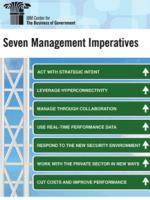
Seven Management Imperatives: Imperative Two: Leverage Hyperconnectivity

From the Pony Express in 1860 to today’s digital revolution, the scope of our connectivity has increased in every dimension. Our connections are faster, farther-flung, and more complete and immersive than ever before. In the last decade, however, we have crossed a significant threshold, from connectivity into hyperconnectivity.
As an example, most urban Americans are rarely more than a few feet away from a device that can not only tell them the weather in Indonesia, but display satellite imagery of the Kuala Lampur Pasar Seni RapidKL train station, and from there allow them to check on the next train arriving on the Kelana Jaya Line.
We are living in a hyperconnected world because at all times we have access—not only to one another—but to data, information, and even things in the real world that are plugged into a sprawling communications infrastructure that never closes down.
Government leaders and managers now confront the challenge of determining how to best use the new tools of hyperconnectivity. We believe that these tools are here to stay. Leaders and managers must now learn how to deploy these tools effectively to their organization’s advantage.
Connecting People to Each Other
Connecting people to each other will help disseminate knowledge organically—offering a deeper and more intuitive understanding of the agency and its protocols than standard documentation is able to impart. By making it easier for employees to communicate and connect—both in real time and asynchronously, both in structured and ad-hoc groups, both in formatted and free-form communications—leaders and managers will enable their employees to maximize both knowledge and time.
Connecting People to Data
Connecting people to data allows an organization to allocate resources based on the needs of the moment. Real-time data are available through any number of channels, such as data feeds and dashboards. These channels will give employees access which will help an organization acquire a nimbleness that may belie its size or bureaucratic structure.
Connecting People to Digital Content
Connecting people to digital content streamlines the creation, editing, vetting, and dissemination process. This applies to any kind of content from speeches to policy papers to internal guidance. Storing documents and applications in the cloud (whether within or beyond the firewall) allows multiple users to work on a document simultaneously, dramatically speeding the time from conception to completion. Further, connecting people to digital content in this way ensures that everyone will always have access to the same draft of every document.
Connecting People to Sensors
Connecting people to sensors is an emerging type of connectivity, and it stands to release tremendous potential for streamlining operations and freeing up resources to be allocated in real time in response to real-time needs. Sensors are all around today:
- RFID (radio frequency identification) tags attached to items of every description that track not only their location, but their condition as well
- Environmental sensors that operate in buildings and outdoors
- Cameras that monitor traffic, watch over facilities, and peer back at employees as they use their laptops
These sensors, if connected to networks and mined for data, can help leaders know what is happening as it is happening, allowing them to base their decisions not on conjecture or possibly outdated information, but on up-to-the-minute and precise measurements.
Looking Ahead
The technologies that enable hyperconnectivity can be harnessed, ignored, employed on an ad-hoc basis, or incorporated thoughtfully into an agency’s strategy to carry out its mission. The only thing that leaders and managers cannot do with these technologies is make them go away, nor can leaders shield themselves or their agencies from every negative side effect. What is certain, however, is that as more leaders and managers learn to connect people to each other, to data, to digital content, and to physical assets, their organizations will reap the rewards in lower operating costs and improved performance.




